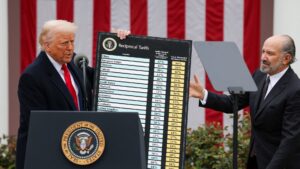The Economic Landscape: Trump’s Tariff Policy and Its Implications
In a significant policy shift, U.S. President Donald Trump recently announced an aggressive new tariff strategy that is drawing parallels to a troubling chapter in American economic history. On April 2, 2025, Trump revealed plans to raise U.S. import duties to their highest levels in over a century. As members of the Extreme Investor Network, we believe it’s crucial to dissect this development and explore what it means for investors and the broader economy.
The Current Tariff Climate
The new tariff framework introduces a baseline import duty of 10%, with steeper penalties imposed on specific countries, particularly China. These tariffs are not random; they are designed to address the trade deficit the U.S. faces with various international partners. According to Sarah Bianchi, chief strategist of international political affairs at Evercore ISI, this brings the effective tariff rate well above the historical high of 20% established by the Smoot-Hawley Tariff Act in the 1930s—a move that many economists blame for exacerbating the Great Depression.
But Trump’s tariffs don’t merely echo the past; they push the average effective tariff rate to a staggering 24%, with projections suggesting it could reach 27% once additional sector-specific tariffs known as "232s" are finalized. The ramifications of this policy shift are profound, impacting not just trade dynamics but investor sentiment across multiple sectors.
The Ripple Effects of Tariffs on Investment
Understanding the implications of these tariffs is vital for investors looking to navigate the uncertain waters of the global economy. As JPMorgan’s chief U.S. economist Michael Feroli highlights, the effective tariff rates are poised to rise from around 10% to just over 23%. This increase, paired with hints of retaliatory measures from trading partners, could create a complex landscape where U.S. companies face higher costs and potentially reduced competitiveness in international markets.
For investors, this raises critical questions:
- Which sectors will be most affected? Industries heavily reliant on imports, such as technology, pharmaceuticals, and automotive, might experience some of the most immediate impacts. Keeping an eye on sectors likely to face supply chain disruptions or increased operational costs will be key.
- Are there investment opportunities amid volatility? While high tariffs may cripple some businesses, they could also present opportunities for domestic companies that can fill the gap left by struggling importers.
Historical Context: Lessons from Smoot-Hawley
In his remarks, Trump referenced the Smoot-Hawley Act, suggesting that if earlier tariffs had been maintained, American economic history might have unfolded differently. This statement serves as a stark reminder of the potential consequences of high trade barriers.
Investors must consider whether history might repeat itself. The Smoot-Hawley tariffs led to widespread retaliation and a significant contraction in global trade, ultimately worsening the economic downturn. If similar patterns occur today, the consequences could be dire, not just for American consumers but for the global economy as a whole.
Looking Ahead: What Investors Should Monitor
The longevity of these tariffs, the responses from foreign governments, and the overall sentiment in financial markets will shape the economic landscape in 2025 and beyond. Analysts, including those from Fitch Ratings, have warned that we may be heading toward the highest tariff levels since 1909—a scenario that carries inherent risks for investors.
-
Pay Attention to Market Signals: Investors should closely monitor stock market reactions and sector-specific performances in the wake of tariff announcements.
-
Diversification is Key: With the potential for economic downturns, diversifying investment portfolios across various sectors may hedge against volatile swings.
-
Engage in Sector Analysis: Focus on industries likely to thrive in higher-tariff environments. U.S.-based manufacturers and companies emphasizing domestic supply chains stand to benefit from these developments.
- Global Perspectives Matter: Tariff impacts are global. Keep an eye on international markets and economies, particularly those that might retaliate, as they can also affect domestic economic health.
Conclusion
The implications of Trump’s new tariff policies are multi-dimensional and fraught with uncertainty. As members of the Extreme Investor Network, we are committed to keeping you informed about economic trends and their impact on your investments. By staying ahead of these developments, you can prepare to navigate this complex landscape effectively.
Remember, the economic tides are constantly shifting; being informed is your best strategy. Join us as we continue to explore the ramifications of these significant policy changes and help you chart a successful investment course.

